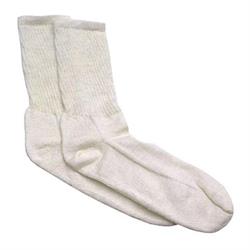'No, Not That Kind of Underwear'
One of the most common questions I get asked when speaking to youth groups or classrooms is, “What do you wear when you race?” Anyone that has seen a race car driver is familiar with the recognizable fire suits and helmets. However, when I answer the question with, “We start with underwear,” I always have to correct the confusion and giggles with, “No, not that kind of underwear.”
While racing underwear may not be as well-known as some of the “flashier” parts of safety gear, it’s definitely no less important. While fire resistant clothing isn’t a necessity for some forms of motorsports, it’s been a necessity for me since 2012 in both my micro sprint and sprint car careers. Needless to say, I’ve learned a lot along the way about the importance of this hot, sometimes thick and uncomfortable piece of clothing. I’m excited to be able to share my knowledge with other racers about this topic.
When I first started wearing underwear, I wore the classic long sleeve top and bottoms, socks, and balaclava (head sock). However, a couple years in I learned that anything underneath your fire suit will melt if it isn’t fire resistant (for example, regular underwear, and bras for the ladies). I learned lesson #1 and switched to a fire resistant sports bra and shorts below my racing underwear instead of the regular versions.
Of course after a few years, like all racecar drivers tend to do after too many fumes and crashes, I started getting a little lazy by wearing less and less fire resistant clothing underneath my suit. That is until I learned from lesson #2 in 2017 at Knoxville Raceway while racing my 360 sprint car. No, I didn’t light on fire. However, I would’ve been sorry if I had. For those that have never raced at Knoxville, drivers leave the driver’s meeting and head directly to change and get into their cars for engine warm up as quickly as possible. If you don’t get dressed fast enough, the flagman, Doug Clark, walks around and yells at the stragglers to move faster, I would know.
I usually have two full sets of racing underwear in the trailer. However, on this particular night, I was rushing to get ready so I could actually be on time when I couldn’t find my underwear in my bag. I had a flashback of two washed and folded sets of underwear back at home, in my bedroom, and not at the track. With a fresh panic attack brewing (and Doug Clark likely grumbling in the background), I decided to wear what I had on underneath my suit and roll with it (highly flammable spandex clothing that is). After engine warm-up, I dug through my bag again, lo and behold found a really old fire resistant tank top with a built-in sports bra that I had outgrown. With the help of another sprint car team, we cut out the built-in sports bra (likely making history at Knoxville as the first team to hand make a fire resistant bra in between races). Additionally, a very generous 410 driver loaned me his underwear to make up for the rest. This particular driver also just so happened to be the same driver I learned lesson #3 from.
As I mentioned, at this point in my career I had started wearing less fire resistant clothing, or in other words, I had begun to just go with fire resistant socks, shorts, and sports bra, leaving out the long sleeved pieces. After all, they were black, hot, and itchy. It wasn’t until the night that I borrowed someone else’s that I realized how much the technology had improved over the years and how magically lightweight and breathable the long sleeve pieces had become.
After talking with the driver about how comfortable they were, he told me how he had been in a sprint car fire in which the sweat on his legs had boiled and given him severe burns. So, it’s important to wear the long sleeve underwear to wick away sweat and moisture to help prevent such severe injuries.
That week I finally learned my lesson and bought a full new set of lightweight, breathable long sleeve underwear. Thankfully, I was able to learn from my mistakes without injury, and I hope that is the case for you all as well. There are many drivers out there that have been seriously injured in fires in our sport and continue to advocate for these important safety devices. So, please make sure you get some fire resistant underwear before you hit the track and best of luck in your 2018 season!
Personally I’ve used a variety of brands including PXP, Lady Eagle, Simpson, and Alpinestar. Select a brand you’re comfortable with and that meets the required safety ratings.
